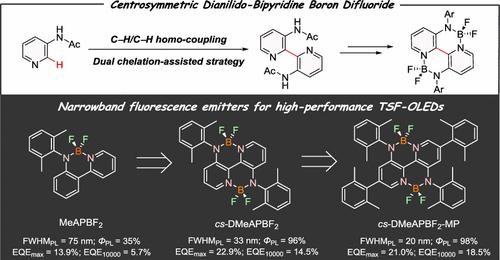揭示窄带荧光发射器设计中的中心对称效应:从单到双双氟硼核
IF 14.4
1区 化学
Q1 CHEMISTRY, MULTIDISCIPLINARY
引用次数: 0
摘要
窄带荧光发射体由于具有制造超高清有机发光二极管显示器(UHD-OLED)的巨大潜力而受到广泛关注。揭示设计新型高性能窄带荧光发射器的创新机制是学术界和工业界的共同努力。理论计算表明,与先前报道的单氟硼核不对称结构相比,中心对称的二苯胺-联吡啶二氟化硼框架(cs-DAPBF2)的结构弛豫明显减少,为窄带荧光发射体的发展创造了新的机会。在这项工作中,我们提出了一种双螯合辅助的C-H / C-H均偶联策略,以有效地合成3,3 ' -氨基-2,2 ' -联吡啶骨架,从而能够直接构建一系列对称的cs- dapbf2基荧光发射体。通过分子优化,我们开发了一种高性能窄带绿色荧光发射器cs-DMeAPBF2-MP,其半峰全宽(fwhm)为20 nm,高光致发光量子产率(ΦPL)为98%,摩尔吸收率(ε)为2.10 × 104 M-1 cm-1,高水平偶极子比(Θ//)为77%。这些特性使cs-DMeAPBF2-MP成为制造效率滚降最小的高效窄带绿色有机发光二极管(oled)的有希望的候选者。该研究代表了DAPBF2架构在高性能oled窄带荧光发射器设计中的首次成功应用。本文章由计算机程序翻译,如有差异,请以英文原文为准。

Unveiling the Centrosymmetric Effect in the Design of Narrowband Fluorescent Emitters: From Single to Double Difluoroboron Cores
Narrowband fluorescent emitters are receiving significant attention due to the great potential for creating ultrahigh-definition organic light-emitting diode displays (UHD-OLED). Unveiling innovative mechanisms to design new high-performance narrowband fluorescent emitters is a concerted endeavor in both academic and industrial circles. Theoretical calculations reveal that the centrosymmetric dianilido-bipyridine boron difluoride framework (cs-DAPBF2) exhibits significantly reduced structural relaxation compared to previously reported asymmetric structures with monofluoroboron cores, creating new opportunities for the development of narrowband fluorescent emitters. In this work, we present a dual chelation-assisted C–H/C–H homocoupling strategy to efficiently synthesize the 3,3′-amino-2,2′-bipyridine skeleton, enabling the straightforward construction of a series of symmetric cs-DAPBF2-based fluorescent emitters. Through molecular optimization, we have developed a high-performance narrowband green fluorescent emitter, cs-DMeAPBF2-MP, which demonstrates a narrow full width at half-maximum (fwhm) of 20 nm, a high photoluminescence quantum yield (ΦPL) of 98%, a large molar absorptivity (ε) of 2.10 × 104 M–1 cm–1, and a high horizontal dipole ratio (Θ//) of 77%. These properties make cs-DMeAPBF2-MP a promising candidate for fabricating high-efficiency, narrowband green organic light-emitting diodes (OLEDs) with minimal efficiency roll-off. This study represents the first successful application of the DAPBF2 architecture in the design of narrowband fluorescent emitters for high-performance OLEDs.
求助全文
通过发布文献求助,成功后即可免费获取论文全文。
去求助
来源期刊
CiteScore
24.40
自引率
6.00%
发文量
2398
审稿时长
1.6 months
期刊介绍:
The flagship journal of the American Chemical Society, known as the Journal of the American Chemical Society (JACS), has been a prestigious publication since its establishment in 1879. It holds a preeminent position in the field of chemistry and related interdisciplinary sciences. JACS is committed to disseminating cutting-edge research papers, covering a wide range of topics, and encompasses approximately 19,000 pages of Articles, Communications, and Perspectives annually. With a weekly publication frequency, JACS plays a vital role in advancing the field of chemistry by providing essential research.

 求助内容:
求助内容: 应助结果提醒方式:
应助结果提醒方式:


